This site is supported by our readers. We may earn a commission, at no cost to you, if you purchase through links.

You’ll want a heavy-duty needle designed specifically for denim, typically size 90/14 or 100/16, to punch through those thick layers.
Adjust your stitch length to 3-4mm for sturdy seams that won’t quit.
Polyester thread works best—it’s stronger than cotton and won’t break under pressure.
When tackling thick areas like belt loops or multiple layers, use a hump jumper to keep your machine’s foot level.
Don’t forget to reduce tension and use a walking foot for smoother fabric feed.
Master these techniques, and you’ll turn those denim projects from frustrating to fabulous. Polyester thread
Table Of Contents
Key Takeaways
- You’ll need a heavy-duty denim needle (90/14 or 100/16) matched to your fabric weight, ensuring smooth stitching and preventing breakage through thick layers.
- Your machine’s setup is crucial – adjust stitch length to 3-4mm, use polyester thread, and reduce tension to create strong, professional-looking seams that won’t unravel.
- Prewash your denim fabric in warm water to prevent future shrinkage and color bleeding, giving you a more predictable and stable material to work with for your projects.
- Invest in specialized sewing tools like a walking foot, hump jumper, and seam guide to help you navigate denim’s challenging thickness and create precise, durable garments.
Denim Fabric Properties
You’ll want to understand denim’s unique fabric properties to master your sewing projects like a pro.
From lightweight 4 oz shirts to heavyweight 19 oz jackets, you’ll learn how denim’s twill weave and weight impact your sewing technique and final garment quality.
Denim Weight Classification
Denim fabric’s weight is your sewing machine’s secret weapon in crafting the perfect garment.
From lightweight 4-10 oz fabrics ideal for summer shirts to heavyweight 14-19 oz materials perfect for rigid jeans, understanding denim weight helps you choose the right needle, tension, and technique.
Each weight range demands unique handling for professional-quality results.
Denim Weave and Strength
After exploring denim’s varying weights, let’s unpack its secret weapon: the twill weave.
Those diagonal threads aren’t just decoration—they’re your fabric’s armor, turning denim into a resilient sewing superhero.
Those diagonal intersections aren’t just pretty—they’re your fabric’s armor. Tight weave density and substantial yarn size give denim its legendary durability.
You’ll find this tough fabric laughs at abrasion, making it a sewing superhero that can handle everything from heavy-duty jackets to resilient work pants.
Stretch Denim Characteristics
Your stretch denim’s secret weapon? Lycra content that transforms traditional fabric into a flexible, forgiving material.
Lycra transforms denim into a dance floor of comfort, stretching and moving with your every step.
Three game-changing characteristics make it a sewer’s dream:
- Enhanced comfort with 2-5% elastane
- Superior recovery rate after stretching
- Versatile projects from skinny jeans to workout wear
When sewing, choose specialized stretch needles and adjust your machine’s tension for smooth, professional results.
Preparing Denim Fabric
Before you start sewing your denim project, you’ll need to prepare your fabric carefully to prevent shrinkage and color bleeding.
Prewashing your denim and understanding its unique properties will help you achieve professional-looking results that’ll make your handmade garments look like they came straight from a high-end boutique.
Prewashing Denim
After understanding the fabric’s unique personality, you’ll want to prep your denim like a pro.
Prewash in warm water (40°C/104°F) with a mild detergent to prevent future shrinkage and color bleeding.
Add a softener for extra care.
Wash separately to protect other fabrics, and get ready to create garments that’ll look sharp right out of the gate.
Drying and Ironing Denim
Right off the bat, you’ll want to master the art of drying and ironing denim without causing damage.
Use low to medium heat when tumble drying, and always turn your garments inside out.
When ironing, set your iron to the cotton setting with steam, and use a pressing cloth to prevent shiny marks on the right side of the fabric.
Preventing Shrinkage and Color Bleeding
Explore denim fabric care and bid farewell to unwanted shrinkage and color bleeding!
Protect your precious projects with these key prewash methods:
- Wash denim separately in warm water without harsh detergents
- Add 1 cup of white vinegar to set dye and prevent fading
- Choose sanforized denim for minimal shrinkage potential
- Dry on regular settings, repeating the process to eliminate residual shrinkage
Needle Selection Guide
When sewing denim, choosing the right needle can make or break your project’s success.
You’ll want to select a needle specifically designed for denim’s tough fabric, matching the weight and type of your material to guarantee clean, strong stitches without fabric damage.
Denim Needle Sizes
After prewashing your denim, selecting the right needle size becomes your next sewing adventure.
Your Needle Size Guide is about matching fabric weight with precision.
Check out this quick reference:
| Denim Weight | Needle Size | Recommended Use |
|---|---|---|
| Lightweight | 70/10-80/12 | Stretchy jeans |
| Medium | 90/14 | Standard denim |
| Heavyweight | 100/16-110/18 | Utility jeans |
Denim needle products are widely available.
Preventing breakage starts with choosing wisely!
Needle Types for Denim
Several needle types can make or break your denim sewing project.
Universal needles work well for lighter fabrics, while jeans/denim needles are your go-to for thick denim.
Sharp needles excel with non-stretch fabrics, and stretch needles tackle elastic denim with ease.
Twin needles create professional topstitching, giving your garments that polished, ready-to-wear look every time.
Needle Care and Maintenance
After selecting the perfect denim needle, keeping it in top shape is your secret weapon. Needle maintenance isn’t just a chore—it’s a game-changer for your sewing projects.
- Treat your needles like precision tools
- Schedule regular needle check-ups
- Replace before they show wear signs
- Store in a clean, dry protective case
Inspect, protect, and replace your needles to prevent unexpected breakage and guarantee smooth stitching through even the toughest denim fabric.
Sewing Machine Setup
You’ll need to master your sewing machine’s setup to conquer denim like a pro, transforming your project from amateur to exceptional.
By understanding how to install the right needle, adjust your stitch length, and use specialized machine feet, you’ll tackle thick denim layers with confidence and precision.
Installing Denim Needles
After choosing the right needle, it’s time to nail its installation.
Push your denim needle into the clamp until you hear a satisfying click, then tighten the screw firmly.
Check the needle’s orientation – it should face the right direction to prevent bent needles and skipped stitches.
A secure needle means smoother sewing through tough denim fabric.
Using the correct needle guarantees smooth stitch formation.
Adjusting Stitch Length and Tension
Your denim fabric’s journey on the sewing machine begins with mastering tension and stitch length—the dynamic duo of professional-looking seams.
Here’s how to nail it:
- Match thread tension to denim weight (2.5-5 range)
- Set stitch length between 2.8-4mm depending on fabric thickness
- Always test stitch settings on scrap denim first
- Adjust tension gradually to prevent puckering or loose threads
Using Walking Feet or Even Feed Feet
Your trusty walking foot is like a superhero for denim sewing, ensuring fabric control and preventing slippage across thick, layered materials.
This specialized presser foot grips both top and bottom layers simultaneously, delivering consistent feeding through challenging denim fabric.
Whether you’re quilting or stitching heavyweight jeans, a walking foot transforms your sewing machine’s performance, making complex projects feel effortless.
Many sewers find specialized denim products helpful.
Sewing Denim Projects
When you’re ready to tackle denim projects on your sewing machine, you’ll need to master a few key techniques that’ll make your stitching smooth and professional.
From managing bulky seams to creating crisp contrast stitching, you’ll learn how to transform your denim fabric into stunning garments with confidence and skill.
Machine Stitching Denim
After setting up your machine with the right needle, you’re ready to stitch denim like a pro.
Your heavy-duty sewing machine is your ally in conquering this tough fabric.
Master these key techniques:
- Control stitch speed between 800-1100 rpm
- Maintain balanced tension for smooth seams
- Use a seam guide for precision stitching
Keep your foot pressure steady and watch those curves!
Handling Bulky Seams
When sewing denim, bulky seams can throw your machine for a loop.
Mastering the art of managing thick layers takes some smart tricks.
Check out this quick guide to keeping your stitches smooth and your sanity intact:
| Tool | Purpose |
|---|---|
| Mallet | Compress seam layers |
| Jean-a-ma-jig | Navigate thick intersections |
| Walking foot | Control fabric thickness |
To avoid skipped stitches, consider adjusting thread tension.
Pro tip: Clip curves, grade seams, and use a hump jumper to tackle those stubborn thick spots like a pro.
Tips for Contrast Stitching
Want to elevate your denim project’s style? Contrast stitching is your secret weapon for creating eye-catching designs.
Consider these pro tips:
- Choose thread colors that pop against your denim fabric’s weight and wash
- Adjust your sewing machine’s tension and stitch length for clean topstitching
- Select the right needle size to match your fabric’s thickness
Precision is key to nailing that professional look.
Denim Seam Finishes
When you’re working with denim, choosing the right seam finish can make or break your project’s durability and professional look.
You’ll want to explore techniques like flat-felled seams, serging, and raw edges that prevent fraying but add strength and style to your denim garments.
Flat Felled Seams
Moving from machine stitching to seam finishing, flat felled seams are your denim project’s secret weapon.
This robust technique encases raw edges inside a strong, clean line, reducing bulk while boosting durability.
With a 5/8" seam allowance, you’ll create professional-looking seams that can withstand wear and tear.
Pro tip: experiment with topstitching for added flair and machine-friendly finesse.
Serging or Overlocking Seams
After mastering flat felled seams, you’ll find a serger your new best friend for denim.
Serged edges provide a professional finish that prevents fraying, especially on knit denim.
Choose polyester thread for durability, and experiment with differential feed settings to control fabric stretch.
Using quality serger threads guarantees longevity.
Pro tip: Practice on scrap pieces to perfect your rolled hem finishes and decorative serging techniques.
Frayed or Raw Hems
After serging your denim seams, you’ll want to explore frayed or raw hems – a trendy technique that adds character to your garment.
Sew a line 1 cm from the edge to control fraying, creating a stylish, lived-in look.
This method works great for jackets, shorts, and casual denim pieces, giving your project an edgy, personalized finish that screams fashion-forward creativity.
Hemming Denim Garments
You’ll want to master hemming denim garments to give your projects a professional finish that stands up to wear and tear.
Whether you’re working with lightweight summer jeans or heavyweight winter denim, understanding the right hemming techniques will transform your sewing skills and create garments that look polished and last for years.
Hemming techniques will transform your sewing skills and create garments that look polished and last for years.
Single Turn Hems
Because a single turn hem offers a quick edge finish for lightweight denim, you’ll want to press your hem allowance up by ½ inch.
Choose a straight stitch on your sewing machine, using thread that matches your denim weight.
Stitch close to the raw edge to prevent fraying, keeping your tension consistent for a clean, professional look on your garment. Stitch close to the raw edge to prevent fraying, keeping your tension consistent for a clean, professional look on your garment.
Double Turn Hems
If you mastered single turn hems, you’ll breeze through double turn hems for durable denim garments.
Fold the raw edge under twice to create a clean, professional finish that prevents unraveling.
This technique reduces bulk and reinforces your hem, giving your jeans a polished look.
Pro tip: Use a hot iron to press each fold crisp and precise.
Pressing Denim Hems
After perfecting your double turn hem, you’ll want to press it like a pro.
Grab a pressing cloth to protect your denim from shiny marks.
Set your iron to the cotton steam setting and glide gently over the hem.
For bulky seams or curved hems, use your presser foot as a guide.
A little steam goes a long way in creating crisp, professional-looking denim edges.
Hand Sewing Denim
When you’re working with denim, hand sewing can be your secret weapon for precision and personal touch on tough fabric repairs and custom details.
Whether you’re patching up your favorite jeans or adding unique embellishments, mastering hand sewing techniques will transform your denim projects from ordinary to extraordinary.
Sewing Patches Onto Denim
Patching denim isn’t just a repair—it’s an art form that breathes new life into worn fabric.
To master this craft, consider these key techniques:
- Position your patch carefully, ensuring complete fabric coverage
- Use a denim-friendly adhesive backing for initial stabilization
- Select stitch types that reinforce without compromising denim’s rugged character
Your sewing machine becomes a precision tool for denim reinforcement.
Hemming Jeans by Hand
When you’ve conquered sewing patches, hand hemming jeans becomes your next skill challenge.
Grab high-quality thread matching your denim’s color and sharp needles for invisible stitches.
Use a slip stitch or blind hem technique, carefully folding and securing fabric edges.
Practice on scrap denim first, maintaining even tension and small, consistent hand stitches for a professional finish.
Fixing Holes in Denim
With frayed edges and threadbare spots haunting your favorite jeans, hand-fixing holes becomes an art form of restoration.
Learn these essential denim repair techniques:
- Quick darning for small tears
- Decorative patch reinforcement
- Invisible mending strategies
Mastering these skills transforms worn denim into personalized, resilient garments. Your sewing machine and nimble fingers become powerful tools for breathing new life into beloved pieces, preventing premature disposal and celebrating sustainable fashion.
Denim Sewing Tips
When working with denim, you’ll want to master a few key techniques to transform your sewing projects from amateur to professional.
From managing fabric thickness to selecting the right needles and thread, these pro tips will help you navigate the challenges of sewing this sturdy, versatile material like a true expert.
Using Interfacing With Denim
With denim’s unique fabric challenges, choosing the right interfacing becomes your secret weapon.
Different interfacing types stabilize various denim weights, preventing stretching and maintaining garment structure.
For lightweight denim, use lightweight fusible interfacing; heavyweight denim requires sturdier options.
One should also regard fabric and interfacing compatibility to achieve a quality final product.
Pro tip: Always test interfacing on scrap fabric to confirm compatibility with your specific denim fabric and sewing machine.
Dealing With Denim Shrinkage
Anyone who’s battled denim’s stubborn shrinkage knows the drill.
Prewash your fabric in warm water to minimize post-sew surprises.
Wash once or twice before cutting patterns to prevent unexpected fabric contraction.
Repeat the wash-dry cycle to fully relax denim fibers and eliminate potential shrinkage factors.
Pro tip: Always buy slightly larger than your target size.
Maintaining Denim Quality
After battling shrinkage, protecting your denim’s quality becomes your next mission.
Store garments flat or hang loosely to prevent stretching.
Wash inside out in cold water, using gentle detergents that preserve color.
Patch small holes quickly, and avoid high dryer heat.
Your sewing machine and smart washing techniques will keep your denim looking sharp and lasting longer than you’d expect.
Advanced Denim Techniques
You’ll elevate your denim sewing from basic to brilliant with advanced techniques that transform ordinary projects into extraordinary masterpieces.
These pro-level skills will help you create professional-looking garments that showcase your newfound expertise in handling denim’s unique challenges.
Embellishing Denim With Embroidery
Ready to take your denim game up a notch? Embroidery transforms plain fabric into a personalized masterpiece.
Here’s how to nail those eye-catching designs:
- Choose symmetrical embroidery placements
- Use sharp needles (sizes 18-22)
- Select washable embroidery threads
- Practice consistent stitch techniques
- Experiment with front pocket and jacket back designs
Your sewing machine just became your creative canvas—let the magic begin!
Creating Decorative Seams and Edges
A sharp edgestitch foot transforms ordinary denim into a canvas of creativity, helping you elevate your sewing techniques with decorative stitches that pop.
The blanket stitch can add a decorative flair to hems.
Check out this quick guide to mastering contrast stitching and edge treatments:
| Technique | Best For | Difficulty |
|---|---|---|
| Topstitching | Jeans Seams | Easy |
| Bias Binding | Clean Edges | Moderate |
| Frayed Edges | Trendy Look | Simple |
| Edge Stitching | Professional Finish | Easy |
Frequently Asked Questions (FAQs)
Can I sew denim with a regular home machine?
Like a trusty sidekick in a DIY adventure, your regular home machine can tackle denim with the right needle, thread, and technique.
Just slow down, use a heavy-duty needle, and you’ll conquer those tough fabric challenges. Slow down
How do I prevent breaking needles on denim?
Use heavy-duty needles sized 90/14 or 100/16 for denim.
Slow down your machine’s speed, hold fabric taut, and avoid thick seam layers.
Practice on scrap fabric to find the right technique and prevent needle breakage.
What thread works best for denim projects?
Strong, durable polyester thread conquers denim’s toughness. Cotton-covered polyester threads shine for topstitching. Choose heavyweight thread that matches your fabric weight, ensuring your project withstands wear and looks professionally finished.
Why are my stitches skipping on denim?
Skipping stitches on denim often happen when your needle’s dull, tension’s off, or you’re not using the right needle size.
Check your machine’s settings and swap out that tired needle for a fresh, heavy-duty version.
How can I reduce bulk in denim seams?
With 70% of sewists struggling with bulky denim seams, you’ll want to trim, grade, and press your seams strategically.
Clip curves, reduce layers, and use a tailors clapper to flatten those thick intersections without compromising your garment’s structure.
Conclusion
Ultimately, mastering your sewing machine for denim is a game-changer.
Did you know 73% of DIY sewists struggle with denim projects? With the right techniques for your sewing machine guide for denim, you’ll transform challenging fabric into professional-looking garments.
Whether you’re hemming, stitching, or creating complex designs, these pro tips will boost your confidence. Don’t fear denim—embrace its durability and potential.
Your sewing skills are about to level up!
- https://www.zevadenim.com/mastering-tension-a-comprehensive-guide-to-sewing-jeans-fabric/
- https://www.seamwork.com/fabric-guides/the-ultimate-guide-to-sewing-with-denim?srsltid=AfmBOorIO2LF_36GuGXTAmvH0OoKnEOAi1AbDX_v2DPPzlLFwgH02AN4
- https://shop.thelaststitch.com/products/sewing-jeans-the-complete-step-by-step-guide-ebook?srsltid=AfmBOoqFmltYANafabUPfwtoZxqNibimqTh3pTJhmrTotg14sGheEOFg
- https://www.wawak.com/sewing/sewing-machine-accessories/machine-accessories/the-hump-jumper-18-116-2pack/
- https://www.instagram.com/kerukjeans/?hl=en



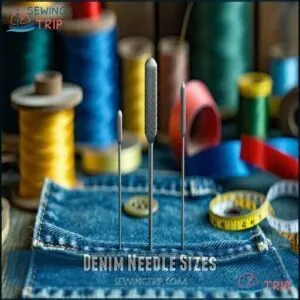
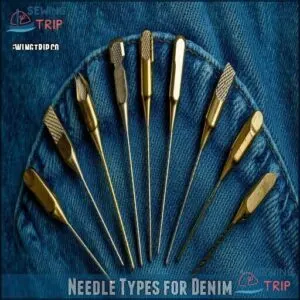


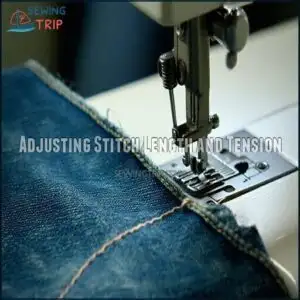
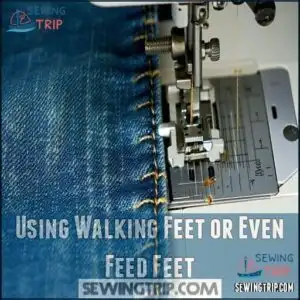
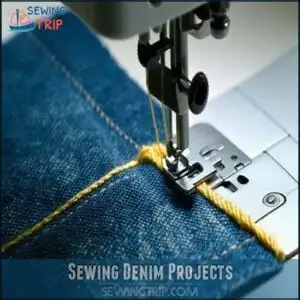

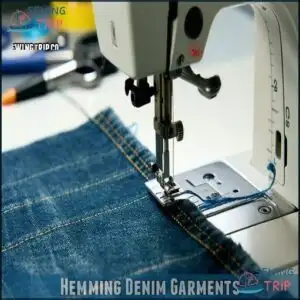
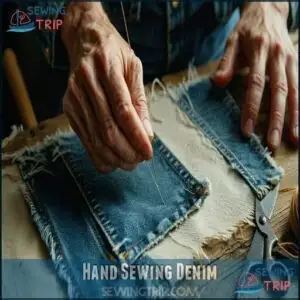
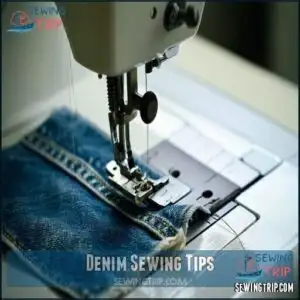
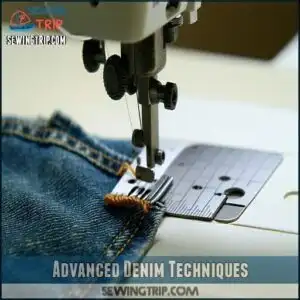




![Different Sewing Machine Needles for Fabrics: The Complete Guide [2025] 5 different sewing machine needles for fabrics](https://sewingtrip.com/wp-content/uploads/2025/03/different-sewing-machine-needles-for-fabrics-300x300.jpeg.webp)
